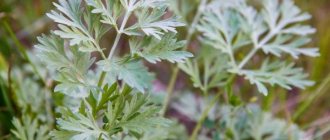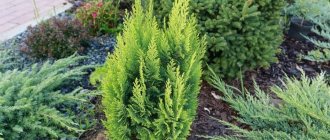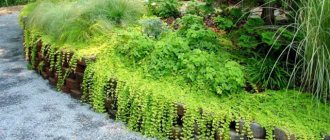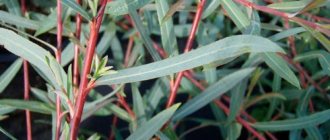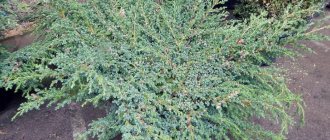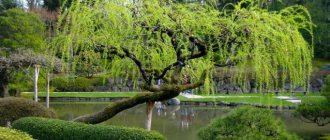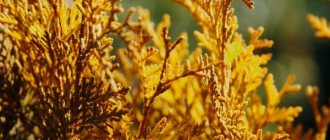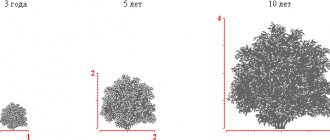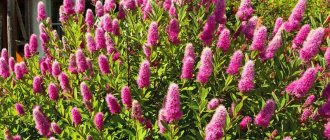Description of the variety
This plant crop belongs to the dwarf variety of western thuja. This variety was bred through selection in Denmark in the middle of the 20th century, for which it received its name. An adult plant has a height of 0.5–0.8 m and 1 m in width. This plant grows slowly, so it does not require frequent pruning. The annual growth is about 5 cm in height and 4 cm in width.
Danica is distinguished by its regular shape in the form of a small ball, which does not change during growth. The crown has a dense structure with needles that are soft to the touch.
The coniferous covering is evenly distributed on the branches that grow vertically, forming a ball shape in a natural way. Throughout the entire season, the thuja maintains a rich green color with some glossy shine. There is also a variety of Danica with yellowish needles (Aurica).
This thuja does not grow quickly, but it is a long-lived species of vegetation - its age can reach 200 years. In these neat bushes, propagation occurs mainly by cuttings, so small cones (up to 6 mm) of brown color are extremely rare on them.
Danica is a frost-resistant variety and can tolerate frosts down to -30°C, but loves good lighting. In shaded areas, its rich color fades, and the bush loses its regular spherical shape. By autumn, the coniferous covering acquires a brown tint and becomes green in the spring.
Did you know? According to Feng Shui, thuja branches brought into a room expel evil spirits from it.
Description of thuja Danika
A slow-growing variety that reaches its maximum size no earlier than 15 years of age, it was bred in the middle of the last century by Danish botanists. Since then, thuja has become one of the most popular when decorating small areas where it is difficult to find space for larger crops.
According to the description, Thuja Danika is a coniferous evergreen shrub, the crown of which consists of many shoots densely covered with soft needles. Most of the branches are directed upward, which gives the small plant additional “fluffiness”. The young needles covering the ends of the shoots are needle-shaped. Later it takes on the appearance of scales tightly adjacent to the wood. In the summer, the crown of the western Danica thuja is painted in rich green tones. By autumn the needles turn brown and remain that way until spring.
Plants are long-lasting. With proper care, like other varieties, Thuja Danica can reach an age of 150 years.
Of course, today there are no such old copies yet. But landscape design lovers now have access to Thuja Danica Aurea, even more original than the traditional plant. This shrub has not green, but bright golden needles. It can withstand frosts down to –29 °C, but is equally winter-hardy and at the same time more dependent on sunlight. The unusual shade of the needles fades in the shade, and the crown of both the regular and the golden conifer gradually loses its spherical shape, becoming ragged and sloppy.
Like all conifers of this genus, this variety of thuja blooms almost imperceptibly. Occasionally appearing brownish-brown cones have a round shape and a diameter of no more than 6 mm. However, the seeds are not suitable for propagation. In culture, this compact form spreads only through cuttings.
Use in landscape design
Thanks to its beautiful low spherical shape, thuja Danica is often used in landscape design of garden plots. It looks unusual in group plantings. It is used to make low hedges along alleys and beautiful green borders. These spherical, neat bushes can be grown in tubs and placed near buildings for decorative decoration.
Containers can be rearranged in any order, forming different compositions. In a tub they are taken out to the loggia or terrace for landscaping.
Danica can be used to create alpine slides, or planted individually. This thuja is often planted when arranging a garden or summer cottage to create a patio (recreation area). These dense balls tolerate haircuts well and can be shaped into various fancy shapes (animals, hearts, etc.).
They can be planted with other coniferous plant crops, as well as barberry, purple coneflower, lilac and plants with a core system, whose roots go deep and do not interfere with the growth of the surface roots of the thuja.
The lush greenery of the thuja goes well with bright roses; In addition, these plant crops have the same requirements for soil composition.
The small ball of thuja Danika looks impressive in combination with coniferous trees that have a columnar or pyramidal shape.
With their help, you can create a triangle that will well decorate part of the territory. For this purpose, you can take thuja Smaragd - its higher cone-shaped crown will harmonize beautifully with Danika’s ball.
Varietal composition
There are 2 types of Danica:
- Traditional (Thuja occidentalis Danica).
- Golden (Thuja Aurea Danica).
The latter variety is also called Yellow and Thuja occidentalis Danica “Aurea”. The main difference from the traditional one is the golden color of the needles. The variety was developed in 2002. Grows up to 800-1000 cm in diameter and height. The cones are larger, 90-120 mm.
The closest relative of the thuja Danica is Globosa. Externally, both varieties are very similar, only the latter type grows up to 1 m, as well as in diameter. Two plants have a spherical crown shape, do not require care, and tolerate drought and frost well.
In landscape design, Globoza and Danika are a successful combination.
Thuja "Aurea" grows up to 1000 cm in height
Landing rules
Arborvitae seedlings are planted in spring or summer so that they begin to grow before the onset of frost. To do this, choose well-lit areas or partial shade - in shaded areas they lose their aesthetic appearance. This plant crop is not picky about soil, but grows better in light, nutritious soil with an acidity of 4.5–6 pH.
Groundwater should not be located close to ground level so that the root system does not rot, as this can lead to the death of the plant crop. The site should be well protected from gusts of northern winds.
Important! The root collar should not be buried - it should be located at ground level. Otherwise, the plant will develop poorly and may die.
It is better to plant seedlings in a permanent place in the evening or morning , when there is no solar activity. For planting along alleys as green borders, seedlings are planted at intervals of 0.3 m - in this case, as the thuja grows, it forms a beautiful green fence.
When planting in a single copy, thuja is placed at a distance of 0.5 m from other plant crops, which allows the formation of an even, neat green ball.
Video: planting thuja Danika
When landing, perform the following actions:
- They dig a hole depending on the parameters of the root system: it should be slightly larger than the straightened roots. As a rule, the depth is 0.7-0.8 m.
- If the soil is dense and clayey, a drainage layer of gravel or broken brick at least 15 cm thick is laid at the bottom.
- Then a nutritious soil mixture is prepared. To do this, the excavated soil is mixed with mineral fertilizers and organic matter.
- A little soil is poured into the hole and a seedling is placed.
- Then carefully cover it with earth, lightly compacting it.
After planting, abundant watering is carried out and the area around the crown is mulched. Peat, compost and sawdust are used as mulch.
Diseases and pests of thuja western Danica
The plant is resistant to pests and diseases, but the risk of damage still exists:
A healthy plant is resistant to pests
- Aphids and spider mites cause yellowing of needles.
- Due to pine-eating insects, the needles turn brown and the tops of the shoots dry out.
- Root pests cause a general deterioration in the condition of the plant and loss of its decorative qualities.
Attention! There are many chemicals used to protect against harmful insects. It is important to determine the nature of the disease in order to choose the right treatment.
Diseases of thuja western Danica:
- brown mold;
- trunk rot;
- Root rotting.
The remedy for any rot is radical - burning the affected plant so that the disease does not spread to other residents of the garden. Prevention - spring spraying with fungicide. Brown mold, which manifests itself during spring thaws, is less aggressive. Destroy dead parts of the tree. Caring for healthy elements involves antimicrobial spraying.
Features of care
In order for the thuja to please with its green and lush form, it is necessary to organize proper care for it. This plant must be properly moistened, nourished and pruned. Young specimens need help to survive the winter.
Watering and fertilizing
The first time after planting the seedlings, it is necessary to carry out regular watering, especially in hot weather. 10–20 liters of water are poured under each bush. It is recommended to loosen the soil afterwards to improve the supply of moisture and oxygen to the root system. It is worth noting that you need to loosen no deeper than 6-7 cm , since the roots of these conifers are located close to the ground level.
Important! Thuja is resistant to many diseases and pests, but can be affected by spider mites, leaf rollers, moths, thuja pine beetles and scale insects, as well as fungi. Therefore, it should be inspected every six months.
In dry weather, it is useful for thuya to sprinkle with warm water. In order for the needles to have a rich green color, it is necessary to apply mineral fertilizers (ash, saltpeter) in the spring. Organic is also good. In spring, nitrogen-containing fertilizers should be used, and in summer, nitrogen-phosphorus fertilizers. From August, potassium is added instead of nitrogen to prepare the crop for the winter.
Ready-made mixtures with nutrients include Kemira Universal or special fertilizers for conifers. They can be purchased without any problems at any garden store.
Trimming and shaping
Thanks to the slow growth of shoots, thuja Danica does not need frequent pruning. You only need to carry out pruning in the spring for sanitary purposes - remove dry and damaged branches, as well as yellowed needles.
It is important to ensure that coniferous branches do not touch the soil , as this will cause the process of rotting, so be sure to trim the lower shoots. It is not necessary to do formative pruning, since this variety already has a beautiful shape.
Growing and care
Danika is unpretentious, but such thujas also require an appropriate approach. You need to start by choosing a suitable location. This area can be located either in partial shade or be well lit. By the way, the last option is more suitable. If Danika receives a lot of light, then her crown will be lush and green.
As for the choice of soil, the plant is not picky about it. The main thing is that it is nutritious and moisturized. You can grow thuja from ready-made seedlings, cuttings and seeds. In the case of cuttings, long and complex care will be required, since the branches need to be rooted. It is also quite difficult to get a plant from seeds, since growth is very slow and you have to wait a long time. It is best to choose seedlings from a nursery. If it is located in the same region where thujas will grow in the future, then acclimatization will not be necessary. Additionally, seedlings do not need to be fertilized. When choosing seedlings, you need to pay attention to their shade - it should be bright green.
Thuja care (video)
It is recommended to plant the plant in the morning or evening, when the sun's rays are not so hot. The hole should be made slightly larger in size than the root system of the seedlings. Be sure to follow the landing rules. Place a drainage layer at the bottom of the hole. You can use gravel, expanded clay, broken brick. Then you need to mix peat with sand and turf. The root collar should be left at ground level; it should not be exposed or buried. Mulching is recommended. Sawdust, dry leaves and sand are suitable for this. Planting is allowed between March and November.
It is necessary to monitor soil moisture. Watering should be correct and plentiful, especially if the summer is very dry and hot.
You should pour at least 15 liters under the bush, remove weeds, and loosen the soil. But you shouldn’t go too deep so as not to damage the root system. At first, you will not need to use fertilizers if you select seedlings from a nursery. But in the future, to make the crown denser, it is recommended to use organic fertilizers. In this case, the soil needs to be dug up and loosened a little. It is best to do this from mid-spring to mid-summer. It is recommended to apply mineral fertilizers (ash and saltpeter). The variety tolerates frost well, but in the first 2 years the bushes need to be insulated, since they have not yet had time to get stronger. To do this, use burlap and spruce branches.
Features of reproduction
Thuja Danica is propagated using cuttings. This method allows you to transfer all the properties of the mother plant to the seedlings. Thuja from cuttings will have the same spherical crown, needle color and small size.
2-year-old shoots, about 10-15 cm long, are suitable for harvesting cuttings. They should not be cut, but broken off together with the “heel”, this will promote better rooting.
Description of the rooting process:
- The needles are removed from the bottom of the cutting.
- For rooting, take a planting container and a loose soil mixture (turf soil, sand, peat).
- Place the cuttings in the soil to a depth of 5 cm.
- Then moisten with a spray bottle.
- Cover the cuttings with a bag and place them on a bright, warm windowsill.
- Periodically open and spray with a spray bottle, maintaining 100% humidity, making sure that mold does not form.
- After 2-3 months, the cuttings will begin to take root.
In the spring, rooted cuttings can be planted in a garden bed for further growing, and a year later they can be planted in a permanent place.
Application in design
The spherical thuja is loved by landscape designers, who use it as a hedge, decorate the banks of artificial reservoirs, plant it in borders and design flower beds with rock gardens.
- Green balls look great on patios, on open terraces, in small areas next to their pyramidal and columnar relatives.
- A little imagination - and with the help of a spherical thuja you can create unique compositions that will decorate the area in front of the house, in the courtyard or in the park and recreation area.
- The aroma of phytoncides will not only remind you of summer, but also heal throughout the year if thuja is used in winter garden compositions, grows on an insulated loggia, and even in the house. Essential oils of cypress bush have proven antiviral and antibacterial effects.
- Plants look great in hallways, offices, and on the staircases of buildings, creating an atmosphere of comfort.
With Danika's help, children's and leisure centers are creating fairy-tale meadows, combining artificial lawns with real plants. Wonderful compositions can be found in parks and squares, arboretums, because the imagination of passionate gardeners is limitless, and Thuja Danika is an excellent assistant in realizing the most daring ideas.
Care
Caring for Danika will not be difficult and will not take much time. It consists of standard operations that the most inexperienced or busy gardeners can do.
Watering
Moderate watering leads to a juicy and shiny color of the needles. However, excessive and prolonged moisture can lead to rotting of the roots.
The procedure is carried out only after the surface layer has dried. Humidification should be plentiful: such a small plant needs at least 8 - 10 liters of water.
Thuja is demanding on the quality of watering
In hot weather, the thuja requires sprinkling, as strong evaporation occurs through the coniferous blades.
Proper watering (2 times a week in hot weather and 1 time a week in moderate temperatures) will not only improve the appearance of Danica, but also increase the evaporation of essential oils, refreshing the air in the area.
Feeding
Evergreen conifers do not require constant feeding and do not tolerate excess organic matter at all.
If mineral fertilizers are applied during planting, then the thuja is not fertilized over the next 2 years.
Starting from the age of 3, special products containing a reduced percentage of nitrogen are introduced.
Note! Excess nitrogen has a bad effect on the decorative properties of thuja and makes the needles loose due to excessive shoot growth.
Mulching and loosening the soil
Weeds take away nutrition from the root system and serve as a breeding ground for pathogenic fungi and pests, so their removal is a mandatory operation when caring for Danika.
During this, it is advisable to loosen the soil to ensure air access to the roots. However, this procedure should be done with caution, not going deeper than 10 cm, so as not to damage the surface roots.
The process of removing weeds and loosening becomes less labor-intensive if you mulch the tree trunk circle.
For ornamental plants, a coating made of special water- and breathable geotextile is used, which prevents the germination of weeds.
The top is mulched with bark, pebbles or wood chips. The soil under such shelter remains moist and loose.
Trimming
Thanks to the natural spherical crown, Danika does not need a shaping haircut, unless you plan to make garden figures from it.
This operation is not performed before the age of 3, otherwise it may weaken the plant. Typically, no more than 1/3 of the branch length is removed.
It is advisable to perform a sanitary haircut regularly, in the spring, when the snow has melted.
During the process they get rid of:
- gray-brown diseased shoots;
- damaged branches;
- stems that are broken or growing in the wrong direction.
The operation is performed with a sharp, disinfected instrument.
Preparing for winter
Danica is a frost-resistant variety, but before wintering it is recommended to cover the bush with spruce branches or build a special frame on which to stretch burlap.
This is done for the purposes of:
- preventing the crown from breaking due to fallen snow;
- protection against spring sunburn.
It is better to throw a layer of snow on top of the shelter to protect the plants from severe frosts.
Types and varieties
Of the varieties of western thuja Danica, there is only one variety, this is Danica Aurea .
Just like the more popular variety, it is highly valued for its very small size. It has a gilded color, and in itself it looks laconic. It is often used in rock gardens, also in group plantings with completely different conifers. Various designers also advise using Aureu if you plan to decorate your own garden in Japanese style.
And, of course, like Danica, the plants are used to green rock gardens.
The growth rate is actually similar, perhaps just a little less - 2-4 centimeters per year, and the maximum height reaches about 0.8 meters. Experts also recommend protecting the flowering tangle from winter and spring burns for the first couple of years.
- It has scaly needles, as soft and as thick as thuja Danika.
- Growth conditions must be met. The variety is light-loving and grows, as a rule, on fertile soils.
- A special feature is that in winter it takes on a distinct shade of bronze.
It has extremely high winter hardiness, but certain conditions must be met, namely, Danica Aurea needs shelter from the early sun in the spring, which is very important. Regarding spring, during this season it is recommended to carry out preventive treatment against any pests, even though Aurea is characterized by unusually high resistance to diseases.
For care we recommend Kemiru Universal
especially in the spring, but only a few years after planting, unless, of course, there was fertilizer consisting of minerals. In the very first month, it is worth spending ten liters a week on watering and sprinkling. In dry conditions, to which the plant is rather poorly tolerated, you should spend about twenty liters, twice a week, otherwise the crowns of the plant will begin to thin out, which few people will like.
Preparing to plant thuja
Thuja spherical Danica can be planted almost all seasons. But experienced gardeners prefer spring planting, so that the plant has time to get stronger and easily withstand frost.
To purchase a spherical thuja, you need to contact a specialized nursery. In this case, you can be sure that the decorative appearance of the variety will be preserved, and the seedlings will be adapted to a specific growing region.
How to choose a place
Danica grows well in turf soil with the addition of peat and sand. But spherical thuja can also grow on other soils: clayey or marshy. The advantage is that thuja does not care about acidity.
The place should be windless and moderately shaded. Strong sun not only dehydrates the plant, but sometimes destroys it.
The size of the planting holes depends on how developed the root system of the seedling is. The hole should be deeper and wider by approximately 30 centimeters. A little compost or rotted manure is poured into the bottom of each hole.
Step 1. Select the optimal planting time The best option is spring, when the soil has already warmed up. The second option is autumn
It is important here that there is at least a month left before frost for the plant to take root. Planting in summer is extremely undesirable, since the plant does not tolerate heat well, and adaptation becomes more difficult. Seedlings should be in pots; they should be removed immediately before planting so that the soil ball does not dry out
Step 2: Select a location and prepare the hole Consider the space occupied by the globular thuja once it has grown
If you are making a continuous hedge, then place the plants at a distance of 50-60 cm from each other. Choose lightly shaded areas so that the plant has both sun and shade during the day. If there is no shade, this can lead to sunburn, especially in early spring. Dig a hole. It should be slightly larger than the earthen ball that you will plant. You can add a layer of drainage to the bottom, in which case the hole is made deeper. Add any complex fertilizer for coniferous plants in the amount of 50-60 g under the roots.
Step 3. Prepare the plant for planting Remove the seedling from the pot or other container immediately before placing it in the ground. The less the root system dries out, the better. Examine the plant. If there are dried shoots or remains of dried pine needles, remove them. Dead debris often harbors diseases and pests.
Step 4. Plant the thuja Insert the plant into the hole and make sure that the root collar is level with the ground. If necessary, deepen the hole a little or add a little nutrient mixture into it. Level the plant and carefully add soil on all sides. If the soil is fertile, then it will do. If the soil at the planting site is not very good, it is better to purchase a special nutrient mixture
Step 5. Compact the soil and water the plant. If you are planting a small version, you can press the soil with your hands. If the seedling is large, it is easier to trample it with your feet. Compact several times and add soil until the surface is level. Water the plant with clean warm water. An average seedling needs about a bucket
